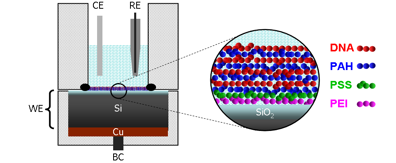Go to
William Garyfallou
Post-doctoral Researcher, Department of Chemical Engineering, Delft University of Technology, Delft, The Netherlands
Electrical Characteristics of Electrolyte-Oxide-Silicon Sensors:pH Sensing and Polyelectrolyte Adsorption
Our overall aim within this project is the development of a reliable and inexpensive sensing device towards the detection of specific mycobacterial components such as nucleic acids and proteins. Our current research focuses on the use of silicon-based EOS structures for capacitive sensing, exploiting the sensitivity of the silicon (Si) space charge region to the adsorption/immobilization of charged molecules. We employ the use of Electrochemical Impedance Spectroscopy (EIS) as an accurate and non-invasive method to detect interfacial changes.
On-going work involves the use of polyelectrolyte multilayers (PEMs) by layer-by-layer (LbL) deposition for the creation of stable platforms (inset Figure 1), which can further be functionalized with bio-recognition elements such as antibodies or ssDNA. The deposition of PEs onto SiO2 induces pronounced changes in the overall sensor capacitance under depletion conditions, while changes under accumulation conditions are negligible. This observation is explained by changes in the space charge region of the semiconductor substrate.
The PE-on-SiO2/Si design is of special interest for the development of sensors since the resulting platforms are simple to fabricate, bio-friendly and very sensitive to interfacial changes.

Figure 1. Schematic representation of a 3-electrode setup (CE = Pt Couter Electrode, RE = Ag/AgCl Reference Electrode, and WE = Working Electrode). The WE consists of a SiO2-covered Si sample onto which polyelectrolytes (PEs) are adsorbed. The following PEs have been used to prepare a multilayer: DNA, poly(allylamine) hydrochlorite (PAH), polystyrene sulfonate (PSS) and polyethelene imine (PEI).
About the Speaker:
 William Garyfallou received the B.Sc (Hons) degree in Genetics and Molecular Biology (University of Wolverhampton, UK, 2002) and the M.Sc degree in Applied Molecular Microbiology (University of Nottingham, UK, 2003). He obtained the Ph.D degree in the field of electronic immuno-interfaces and surface nanobiotechnology from Cranfield University, UK in 2009. Since fall 2009 he works as a postdoctoral researcher on the development of a sensor platform to detect Mycobacterium tuberculosis-specific components at TU Delft, Department of Chemical Engineering.
William Garyfallou received the B.Sc (Hons) degree in Genetics and Molecular Biology (University of Wolverhampton, UK, 2002) and the M.Sc degree in Applied Molecular Microbiology (University of Nottingham, UK, 2003). He obtained the Ph.D degree in the field of electronic immuno-interfaces and surface nanobiotechnology from Cranfield University, UK in 2009. Since fall 2009 he works as a postdoctoral researcher on the development of a sensor platform to detect Mycobacterium tuberculosis-specific components at TU Delft, Department of Chemical Engineering.
Secondary navigation
- EPFL Workshop on Logic Synthesis and Emerging Technologies
- Luca Amaru
- Luca Benini
- Giovanni De Micheli
- Srini Devadas
- Antun Domic
- Rolf Drechsler
- Pierre-Emmanuel Gaillardon
- Jie-Hong Roland Jiang
- Akash Kumar
- Shahar Kvatinsky
- Yusuf Leblebici
- Shin-ichi Minato
- Alan Mishchenko
- Vijaykrishnan Narayanan
- Ian O'Connor
- Andre Inacio Reis
- Martin Roetteler
- Julien Ryckaert
- Mathias Soeken
- Christof Teuscher
- Zhiru Zhang
- Symposium on Emerging Trends in Computing
- Layout synthesis: A golden DA topic
- EPFL Workshop on Logic Synthesis & Verification
- Luca Amaru
- Luca Benini
- Robert Brayton
- Maciej Ciesielski
- Valentina Ciriani
- Jovanka Ciric-Vujkovic
- Jason Cong
- Jordi Cortadella
- Giovanni De Micheli
- Antun Domic
- Rolf Drechsler
- Henri Fraisse
- Paolo Ienne
- Viktor Kuncak
- Enrico Macii
- Igor Markov
- Steven M. Nowick
- Tsutomu Sasao
- Alena Simalatsar
- Leon Stok
- Dirk Stroobandt
- Tiziano Villa
- Symposium on Emerging Trends in Electronics
- Raul Camposano
- Anantha Chandrakasan
- Jo De Boeck
- Gerhard Fettweis
- Steve Furber
- Philippe Magarshack
- Takayasu Sakurai
- Alberto Sangiovanni-Vincentelli
- Ken Shepard
- VENUE
- Panel on Circuits in Emerging Nanotechnologies
- Panel on Emerging Methods of Computing
- Panel on The Role of Universities in the Emerging ICT World
- Panel on Design Challenges Ahead
- Panel on Alternative Use of Silicon
- Nano-Bio Technologies for Lab-on-Chip
- Functionality-Enhanced Devices Workshop
- More Moore: Designing Ultra-Complex System-on-Chips
- Design Technologies for a New Era
- Nanotechnology for Health
- Secure Systems Design
- Surface Treatments and Biochip Sensors
- Security/Privacy of IMDs
- Nanosystem Design and Variability
- Past Events Archive

